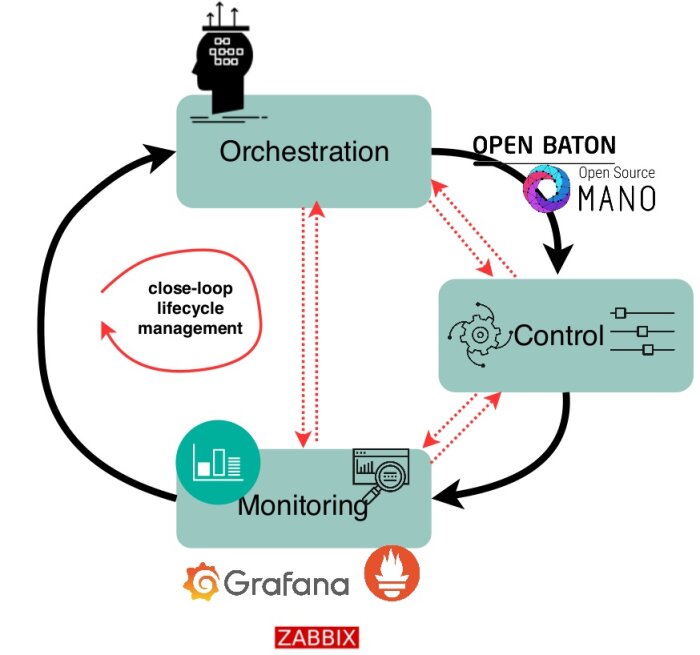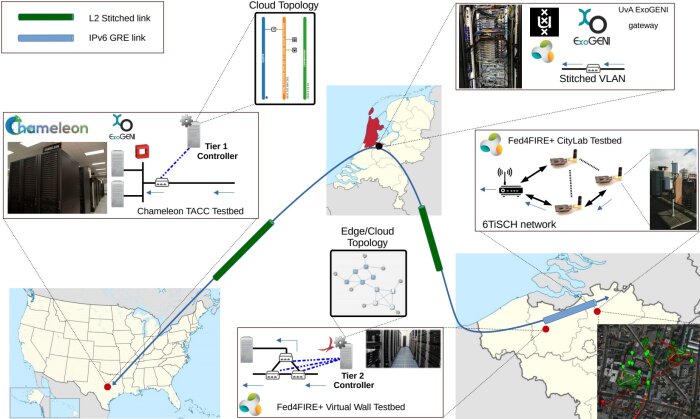Current trends on 5G and AI are pushing network management to its limits. Many new applications such as autonomous driving, haptic sensing, and 3D holographic displaying demand very high computing power with low latency. In order to fulfill these strict requirements, network management has to carefully control the performance of each network domain and network segment.
However, the resources in each network domain are limited and often shared with other third-party applications. In order to solve this problem, network management trends aim towards network slicing techniques and hierarchical multi-domain network orchestration to ensure fine-grained QoS per-flow and flexible end-to-end control of network resources.
Research examples
- End-to-end network slicing: In order to cope with the diverse requirements that services pose to the network such as vehicular communication (V2X), Industrial IoT and Ultra-low latency communications, 3GPP introduced the concept of network slicing, which proposes partitioning the shared physical network infrastructure into independent logical networks, known as Network Slices. Each Network Slice operates as a separate virtual network, individually tailored and configured for serving different purposes, enabling providers to simplify network management by assigning services with different requirements to different customized and carefully dimensioned Network Slices. In this research track we focus on developing reliable solutions to perform Network Slicing on top of several wireless technologies (e.g., in Wi-Fi, LTE, 5G-NR, etc. ) and wired technologies as well, aiming end-to-end network slicing.
- Multi-domain network testing: Optimizing the allocation of network functions, and network slices in hierarchical multi-tier edge/cloud infrastructures to fulfill application requirements, and at the same time reducing the energy consumption, is not a trivial challenge. Since these architectures may involve different network technologies and orchestration platforms, ensuring the end-to-end fulfilment of the service requirements adds an extra level of complexity. Fortunately, testbed facilities allow researchers to explore and to use very flexible and reconfigurable testing environments. This research track aims to integrate different software-defined network solutions (SDN, network slicing, NFVs, TSN, etc.) and jointly deploy them across different network domains (wired, optical, wireless, IoT, etc.) using public testbed facilities (CityLab, Smart Highway, Virtual Wall, w-iLab.t, etc.).
-
 At IDLab, we focus on orchestration, control, and monitoring of the different networking components, and have different tools at our disposal.
At IDLab, we focus on orchestration, control, and monitoring of the different networking components, and have different tools at our disposal. -
 Example of an end-to-end global multi-domain network deployed in three different testbeds: the CityLab testbed (Belgium) for MEC and Smart City experiments, the Virtual Wall testbed (Belgium) for cloud and virtualisation experiments and Chameleon testbed (USA) for large scale cloud and virtualisation experiments.
Example of an end-to-end global multi-domain network deployed in three different testbeds: the CityLab testbed (Belgium) for MEC and Smart City experiments, the Virtual Wall testbed (Belgium) for cloud and virtualisation experiments and Chameleon testbed (USA) for large scale cloud and virtualisation experiments.
Involved faculty
Johann Marquez-Barja
